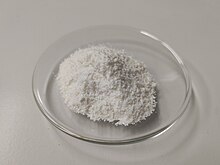
Back حمض النخيل Arabic Palmitin turşusu Azerbaijani پالمیتیک اسید AZB Пальміцінавая кіслата Byelorussian Палмитинова киселина Bulgarian Àcid palmític Catalan Kyselina palmitová Czech Palmitinsyre Danish Palmitinsäure German Παλμιτικό οξύ Greek

| |

| |
| Names | |
|---|---|
| Preferred IUPAC name
Hexadecanoic acid | |
| Other names
Palmitic acid
C16:0 (Lipid numbers) | |
| Identifiers | |
3D model (JSmol)
|
|
| ChEMBL | |
| ChemSpider | |
| ECHA InfoCard | 100.000.284 |
PubChem CID
|
|
| UNII | |
CompTox Dashboard (EPA)
|
|
| |
| |
| Properties | |
| C16H32O2 | |
| Molar mass | 256.430 g/mol |
| Appearance | White crystals |
| Density | 0.852 g/cm3 (25 °C)[2] 0.8527 g/cm3 (62 °C)[3] |
| Melting point | 62.9 °C (145.2 °F; 336.0 K)[7] |
| Boiling point | 351–352 °C (664–666 °F; 624–625 K)[8] 271.5 °C (520.7 °F; 544.6 K), 100 mmHg[2] 215 °C (419 °F; 488 K), 15 mmHg |
| 4.6 mg/L (0 °C) 7.2 mg/L (20 °C) 8.3 mg/L (30 °C) 10 mg/L (45 °C) 12 mg/L (60 °C)[4] | |
| Solubility | Soluble in amyl acetate, alcohol, CCl4,[4] C6H6 Very soluble in CHCl3[3] |
| Solubility in ethanol | 2 g/100 mL (0 °C) 2.8 g/100 mL (10 °C) 9.2 g/100 mL (20 °C) 31.9 g/100 mL (40 °C)[5] |
| Solubility in methyl acetate | 7.81 g/100 g[4] |
| Solubility in ethyl acetate | 10.7 g/100 g[4] |
| Vapor pressure | 0.051 mPa (25 °C)[3] 1.08 kPa (200 °C) 28.06 kPa (300 °C)[6] |
| Acidity (pKa) | 4.75 [3] |
| −198.6·10−6 cm3/mol | |
Refractive index (nD)
|
1.43 (70 °C)[3] |
| Viscosity | 7.8 cP (70 °C)[3] |
| Thermochemistry | |
Heat capacity (C)
|
463.36 J/(mol·K)[6] |
Std molar
entropy (S⦵298) |
452.37 J/(mol·K)[6] |
Std enthalpy of
formation (ΔfH⦵298) |
−892 kJ/mol[6] |
Std enthalpy of
combustion (ΔcH⦵298) |
10030.6 kJ/mol[3] |
| Hazards | |
| GHS labelling: | |
 [2] [2]
| |
| Warning | |
| H319[2] | |
| P305+P351+P338[2] | |
| NFPA 704 (fire diamond) | |
| Flash point | 206 °C (403 °F; 479 K)[2] |
Except where otherwise noted, data are given for materials in their standard state (at 25 °C [77 °F], 100 kPa).
| |
Palmitic acid (hexadecanoic acid in IUPAC nomenclature) is a fatty acid with a 16-carbon chain. It is the most common saturated fatty acid found in animals, plants and microorganisms.[9][10] Its chemical formula is CH3(CH2)14COOH, and its C:D ratio (the total number of carbon atoms to the number of carbon-carbon double bonds) is 16:0. It is a major component of palm oil from the fruit of Elaeis guineensis (oil palms), making up to 44% of total fats. Meats, cheeses, butter, and other dairy products also contain palmitic acid, amounting to 50–60% of total fats.[11]
Palmitates are the salts and esters of palmitic acid. The palmitate anion is the observed form of palmitic acid at physiologic pH (7.4). Major sources of C16:0 are palm oil, palm kernel oil, coconut oil, and milk fat.[12]
- ^ Merck Index, 12th Edition, 7128.
- ^ a b c d e f Sigma-Aldrich Co., Palmitic acid. Retrieved on 2014-06-02.
- ^ a b c d e f g CID 985 from PubChem
- ^ a b c d "Palmitic acid".
- ^ Seidell, Atherton; Linke, William F. (1952). Solubilities of Inorganic and Organic Compounds. Van Nostrand. Retrieved 2014-06-02.
- ^ a b c d n-Hexadecanoic acid in Linstrom, Peter J.; Mallard, William G. (eds.); NIST Chemistry WebBook, NIST Standard Reference Database Number 69, National Institute of Standards and Technology, Gaithersburg (MD) (retrieved 2014-05-11)
- ^ Beare-Rogers, J.; Dieffenbacher, A.; Holm, J.V. (2001). "Lexicon of lipid nutrition (IUPAC Technical Report)". Pure and Applied Chemistry. 73 (4): 685–744. doi:10.1351/pac200173040685. S2CID 84492006.
- ^ Palmitic acid at Inchem.org
- ^ Gunstone, F. D., John L. Harwood, and Albert J. Dijkstra. The Lipid Handbook, 3rd ed. Boca Raton: CRC Press, 2007. ISBN 0849396883 | ISBN 978-0849396885
- ^ The most common fatty acid is the monounsaturated oleic acid. See: https://pubchem.ncbi.nlm.nih.gov/compound/965#section=Top
- ^ Gianfranca Carta; Elisabetta Murru; Sebastiano Banni; Claudia Manca (8 November 2017). "Palmitic Acid: Physiological Role, Metabolism and Nutritional Implications". Frontiers in Physiology. 8: 902. doi:10.3389/FPHYS.2017.00902. ISSN 1664-042X. PMC 5682332. PMID 29167646. Wikidata Q46799280.
- ^ Loften, J.R.; Linn, J.G.; Drackley, J.K.; Jenkins, T.C.; Soderholm, C.G.; Kertz, A.F. (August 2014). "Invited review: Palmitic and stearic acid metabolism in lactating dairy cows". Journal of Dairy Science. 97 (8): 4661–4674. doi:10.3168/jds.2014-7919. ISSN 0022-0302. PMID 24913651.
